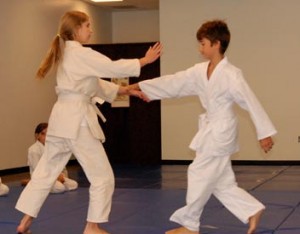 It’s stories like this we find so heartwarming.
It’s stories like this we find so heartwarming.
Gabriel was a charter student in our kids’ class, and in fact began training with us before we even had a kids’ class, before we even moved to our current location on the Southside of Jacksonville. I have a vivid memory of Joel Miller training with Gabriel at the University of North Florida, and remarking to myself the poise that Gabriel possessed, even at that young age. (Of course Joel is now at Austin Aikikai, although we do occasionally cross paths at Winter Camp.) As time moved on, Gabriel pursued his other interests, but his time with Aikido never left him, as he writes below.
It is no surprise that Gabriel has gone on to accomplish so much. He is a senior now, and will be attending the Massachusetts Institute of Technology this fall, after having considered three Ivy League schools and some of the finest engineering colleges in the country. Below is his college application essay. His dad, another of our students, graciously gave us permission to reprint it here.
Thank you, Gabriel, for your kind words, and congratulations again on your success. You’ve made our day.
In my perspective, what marks the transition between childhood and adulthood is when one fully understands self-control. Children react to situations through their instincts and impulses, while adults, with an understanding of self-control, sometimes even go against their instinct to respond accordingly to the situation. From the time I began practicing Aikido, a Japanese martial art created in the 1930’s by Morihei Ueshiba, I started developing self-control, applying it to my techniques within the dojo. However, I had never implemented this principle to any situation in the real world until I faced a life-or-death situation. My accident on the Buckman Bridge signified my transition into adulthood as I had to respond to the situation and face the consequences alone. I realized after the accident that the Aikido teachings were a philosophy to live by, rather than just techniques in the dojo.
I began practicing “the Art of the Warrior” at the age of nine as the first child in the dojo. Starting in the University of North Florida, the Aikido Club of Jacksonville was a small group, consisting mostly of university students. As time passed, Aikido began to play a greater role in my life. Through my instructors, the values of harmony and self-control were instilled in me. Aikido, unlike other martial arts, focuses on diverting oncoming energy towards a solution in which both the attacker and the defender benefit. Principally based on throws and grappling, it not only instructs students techniques for self-defense, but also engenders a philosophy of non-aggressive, non-competitive path-finding in which one finds the most suitable path to solve the issue at hand. Although I did not realize it at the time, this peaceful martial art would play a formative role in my life, of which I would not appreciate until my accident.
During the summer, my daily route to my internship at the Naval Air Station included driving over the Buckman Bridge, which spans three miles long and over 65 feet above the St. Johns River. Fog and heavy traffic were common during my commute, making it perilous.
The evening of the accident, I was driving home from work during rush hour in the right outermost lane. I was peacefully paying attention to the road while humming to “Piano Man” by Billy Joel. With the afternoon Florida sun in my rearview mirror and my evening plans in mind, I continued driving across the bridge like most days. Out of the corner of my eye, however, I saw a car in the adjacent lane suddenly swerve; a heavy metal object materialized in my lane just ahead of my car. Several different plans of action filled my head. Time slowed to a standstill. The three possible options I envisioned were either to swerve right and possibly go into the water, swerve left and crash into the adjacent traffic, or go head-on towards the object. A child’s natural response would have been to avoid the object at all costs, without weighing the consequences. I decided to go head-on towards the object. My main goal was to maintain control of the car, no matter what came ahead. Instead of popping up and breaking through my windshield, the object flew under my car, striking it continuously. Although I struggled to maintain control of the car, I was able to stay in the lane, presenting no danger to adjacent traffic. Instantaneously, the gasoline indicator dropped rapidly and the temperature indicator began to rise. Fearing the possibility of a gasoline fire, I coasted down the exit to a nearby parking lot. Fortunately, only the radiator and the gasoline sensor were damaged.
It was during this accident in which I became an adult. In those few moments before the object hit, I understood what self-control meant: to remain calm enough to respond properly, rather than react impulsively, to any adverse situation. Aikido not only made me an adult, but it saved my life.
What an incredible story. I’m glad it ended without tragedy and that the silver lining is acceptance to MIT. Congratulations on such a great accomplishment, Gabriel. I’m proud of you, especially since I was one of those teachers that helped you learn the Art of Peace.